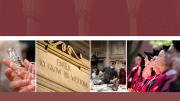The inhabitants of Japan's northernmost island enjoy cold that pierces and snow that blows, but the indigenous Ainu woman who possessed this sealskin coat could scoff at wretched weather and draw admiring glances simultaneously. She might have chosen to wrap herself in the skin of bears, creatures central to the Ainu lifestyle, but sealskin is lighter, harder-wearing, and more water-resistant than other furs.
The coat-maker pieced together in a decorative pattern the skin of perhaps only one seal, if it was a big one. The dark fur in front at center is from the seal's back. The chest and arms of the garment are the hindquarters of the animal. The lighter fur from its belly is at back. Above the coat waist, the lie of the fur is up; below, it is down; light plays differently top and bottom. Fabric appliqué and embroidery, now somewhat faded, decorate the shoulder bands, wrist bands, collar, and front, and a bit of fox fur is at shoulders and wrists. Light and dark blue glass beads adorn the shoulder bands.
|
The Ainu are aborigines of Japan, forced by the Japanese gradually to retreat north to Hokkaido and the Russian Kuril Islands and Sakhalin. After the Meiji restoration in 1868, Japan began to populate Hokkaido with Japanese to firm the northern frontier. The government effectively removed all Ainu lands from their control and offered homesteads to Japanese. New laws compelled the Ainu to speak Japanese, and practicing old customs was prohibited.
Wishing to encourage agriculture on Hokkaido, the Japanese persuaded American experts from regions of similarly unsuitable climate to advise them. In 1877 William P. Brooks of Massachusetts journeyed to Hokkaido's newly founded capital city, Sapporo, to help establish the Sapporo Agricultural College. Brooks eventually served four years as president of the college, now part of Hokkaido University. When he left Japan in 1888 to become professor of agriculture at the Massachusetts Agricultural College and for two years its president he brought home the honor of the Fourth Order of the Rising Sun, given him by the emperor; the Japanese soybean; and this sealskin coat, now at the Peabody Museum of Archaeology and Ethnology.
The age of the coat is not known. One might simply think of it as pre-politically correct, but that would be naive, for sealskin coats are still the rage, favored by the Danish royal court and simple folk as well. A recent fashion piece in the New York Times featured a photograph of a model in an allegedly Inuit-inspired coat by Louis Vuitton, alongside the headline "Sealskin is a girl's best friend."





